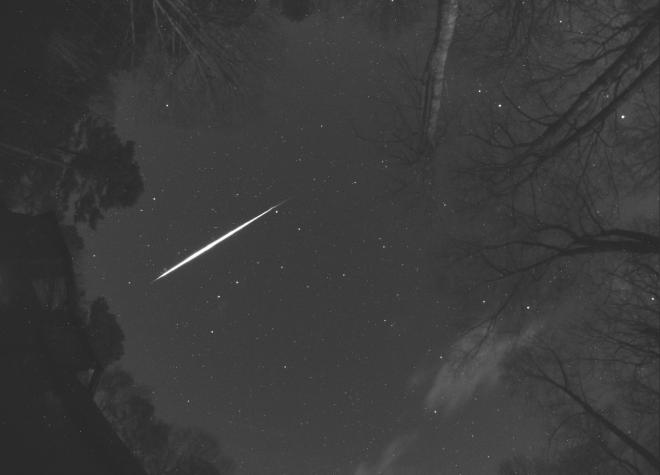View the Geminids! This family-friendly, curfew-friendly meteor shower peaks Sunday night, December 13, 2020
December 10, 2020
By Amy Sayle
If the weather behaves, you have an opportunity for a sky show at a reasonable hour. The annual Geminid meteor shower is happening now and is predicted to peak Sunday night, December 13, 2020.
A few viewing tips:
1) Know what you’re looking for.
Meteors, sometimes misleadingly called “shooting stars,” are streaks of light caused by cosmic debris interacting with Earth’s atmosphere. Typically, this debris has been left by a comet. In the case of the Geminids, the source is an asteroid, 3200 Phaethon.
2) Check the weather forecast now, then pick your date.

You need reasonably clear skies. If it looks like you’ll have cloudy skies the peak night of Sunday, December 13, 2020, you might try the two nights before or one night after.
3) Pick a time.
What if someone in your household has an early bedtime? And what about North Carolina’s 10 p.m. to 5 a.m. curfew?
Here’s the good news: The Geminid meteor shower is famous for producing good meteor activity before midnight. There is no need to go out at some insane hour of the night. In previous years, we’ve held skywatching events for the Geminids from 8 to 10 p.m. on the peak night, and we’ve typically seen meteors soon after 8 p.m. You might even see some earlier than that. These early evening meteors can be spectacular “earthgrazers,” which are long and slow-moving; look northeast for those.
4) Pick a place.
This year, you’ll have to work with what’s available, which may be your own yard or street. Ideally, choose a dark open area away from unshielded lights. This year there will be no interference from moonlight.
If you’re viewing from your own yard, turn off your home lights and consider asking your neighbors to turn off their outside lights. From a reasonably dark site on the peak night, you may see an average of a meteor every minute or so during the late evening hours, fewer early in the evening.
5) Dress warmly.
Really warmly. Warmer than you think you could possibly need to. It can feel awfully cold awfully fast when you’re outside at night not moving around.
6) Pack your supplies.
A blanket, sleeping bag, or reclining chair will help you look at the sky without craning your neck. Consider bringing a thermos with a hot drink.
Avoid using white light. If you do use a flashlight or headlamp, make sure the light is red, as dim as possible, and aimed at the ground. This helps prevent you from ruining your night vision and that of others around you. One way to make an “astronomer’s light” is to trim off the neck of a red balloon and stretch the rest of it over your white light.
7) Look toward the darkest part of your sky.
The Geminid meteors are called that because if you traced them back, they will appear to have originated from the direction of the constellation Gemini. But the meteors can appear in any part of the sky. You don’t need to know how to identify Gemini to see them. You might try simply looking toward the darkest part of your sky.
8) Be patient.
Plan to stay out at least 20 or 30 minutes. Your eyes need time to adjust to the dark, and the meteors can come in clumps, with none for minutes at a time.
9) Remember to look up.
Your eyes are the only observing equipment you need. Just remember to look up at the sky and not at other things, such as the bright night-vision-blasting screen of a cellphone.
10) Know what else you’re seeing in the sky.
You can download our North Carolina star map for December-January here. Be sure to look for Mars. Between 8 and 10 p.m. on December 13, 2020, you’ll find it high in the south to southwest. It’ll be bright, shining steadily (not twinkling like a star), and will look like it has some color—it’s called the Red Planet for a reason.
And what about the Jupiter/Saturn conjunction you may have been hearing about? That’s more of a very early evening sight, before you’ll likely want to start your meteor viewing. More about that conjunction in a future blog post.
11) Call it a success if you see even just one meteor.
Call it a success even if you don’t. You got yourself outside to enjoy nature at night and peer into the universe. And that’s always worth celebrating.
For more skywatching resources, check out our online hub, Morehead At Home.
